Surface Piercing: Types, How Does It Work, And Aftercare
From varieties to aftercare, dive into the depths of surface piercings.

Image: Shutterstock
A surface piercing offers an innovative twist on traditional body art styles, presenting a unique form of self-expression. This format involves jewelry laying flush against your skin, creating a seamless and intriguing visual effect. Unlike the deep punctures required for ear or nose piercings, a surface piercing involves a barbell that gently weaves under the skin’s surface, without penetrating deep muscle or cartilage. Surface piercing has gained popularity for its versatility and ability to accentuate nearly any area of the body, offering a canvas for personal creativity. If you are intrigued by the idea and seeking to make a statement with your body art, take a closer look at what makes these piercings a fascinating choice. Keep reading to learn more about the different types of piercings, healing processes, aftercare methods, and potential risks to be aware of.

 Piercing Guide: Surface Piercing
Piercing Guide: Surface Piercing- Placement: The nape, wrist, sternum, hips, or any other flat skin surfaces
- Best Jewelry: Surface barbells
- Cost: $50 to $100. Additionally, there can be added costs for high-quality jewelry, aftercare products, and potential follow-up visits.
- Pain Level: Low to medium (4-6/10)
- Healing Time: 6 to 12 months
In This Article
Surface Vs. Dermal Piercing
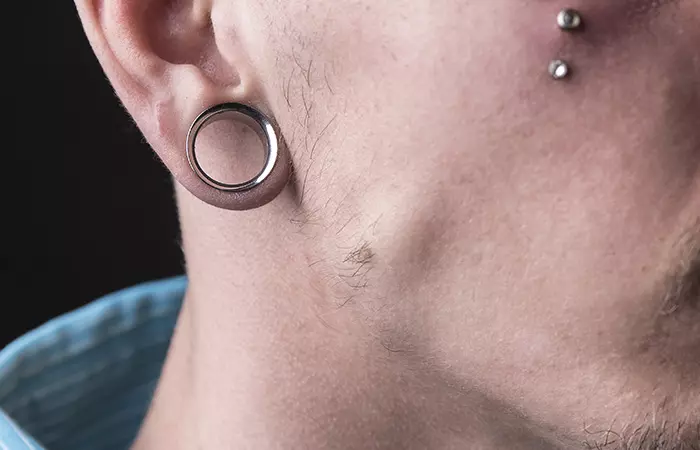
When exploring the realm of body modification, you will likely come across two popular terms: surface piercing and dermal piercing. While they may look similar at first glance, they are quite distinct in their methods and healing processes.
- Surface Piercing
A surface piercing typically involves a barbell that travels beneath the skin’s surface, entering and exiting through two points, creating the coveted double-pierced look. Think of it like a small tunnel lying just below the skin, with both ends visible. Out of the various types of piercings, this one can be done on many flat areas of the body, such as the collarbone or the wrist. The nape piercing is a common example of a surface piercing. It is located at the back of the neck, often centered just above where a necklace might rest. With this piercing, a barbell with two 90-degree bends is inserted under the skin, with both ends emerging parallel to the skin’s surface. The jewelry appears to be two symmetrical beads sitting atop the skin, making for an elegant and understated look.
- Dermal Piercing
A dermal or microdermal piercing involves making a small incision/entry point on the skin where a base called a dermal anchor is inserted. From there, the only visible part is the decorative top, which sits against the skin’s surface. A cheekbone or microdermal piercing is a classic example of a dermal piercing, where the top is screwed onto the visible part of the surface anchor that sits against the cheekbone. Unlike the nape piercing, the cheekbone piercing does not have a visible exit point, creating the illusion of a gemstone or bead magically adhering to the skin. Hence, dermal piercings offer greater placement flexibility and can be placed on curved areas, where traditional surface piercings might not be as viable.
Both styles require diligent aftercare and a skilled piercer who can guide you through the process and aftercare to ensure proper healing. If you are considering a surface piercing or a dermal piercing, it is essential to weigh the pros and cons of each, including healing time, the potential for rejection, and how they complement your style and body.
A surface piercing might seem like a mysterious little body art, but how does that jewelry cling to the skin? Learn about it in the next section.
Key Takeaways
- Surface piercings offer a unique style by laying the jewelry flat against the skin without deep tissue penetration.
- Aftercare, including saline soaks and minimal movement, is crucial for healing.
- Risks like rejection, infection, and migration are common concerns with surface piercings.
- Surface piercings may be re-pierced after removal but require time and healthy healed skin for success.
- Choose jewelry that is body-safe and appropriate for your surface piercing to aid healing.
How Does A Surface Piercing Work?
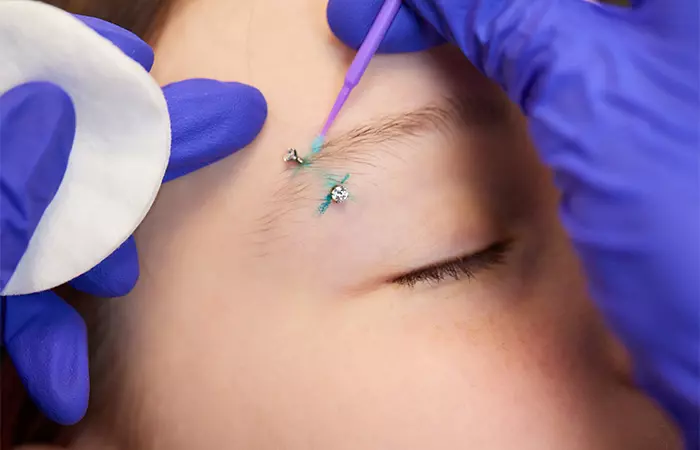
Unlike traditional piercings that go through one and out the other side, surface piercing threads itself parallel to the skin. These types of piercings involve creating two close punctures and connecting them underneath the surface with a special piece of quality jewelry, typically a surface barbell. This barbell is not your average piece; it is shaped with a gentle curve or at a series of right angles, designed to sit comfortably beneath the skin without poking out or causing irritation. When done correctly, the two ends of the barbell peek out from the skin, providing a cool illusion of floating adornments.
For a successful surface piercing, precision is key. It requires a piercer with a steady hand and a keen eye noting your body’s contours. They need to anticipate how your skin moves and accommodate for swelling, ensuring the jewelry is neither too tight nor too loose: It is a bit of art, a touch of science, and a whole lot of skill.
However, as is with all piercings, pain is a significant factor to consider. If the piercing is on the surface, does it hurt as much as the traditional in and out piercing? Check the next section for more.
Is A Surface Piercing Painful?
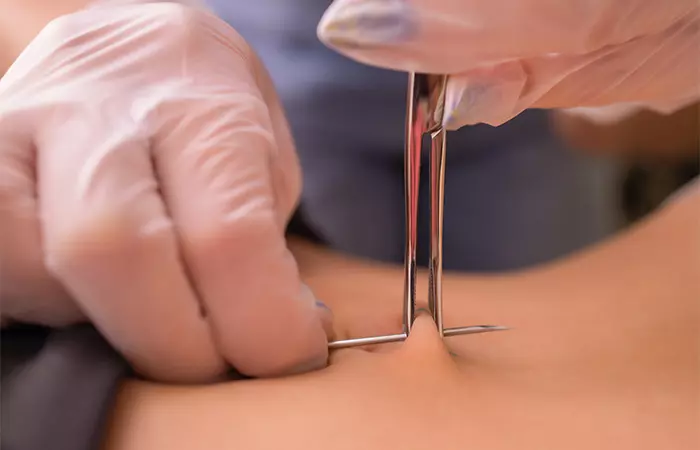
When considering a surface piercing, it is natural to wonder about the pain level. While everyone’s tolerance differs, professional piercers often rank their surface piercing experiences on a scale of 1 to 10, where 1 is a gentle pinch and 10 is intense discomfort. Furthermore, among surface piercings, the ones located in areas with denser nerve endings or closer to bones tend to have higher pain levels. Therefore, we have listed a few surface piercing options and indicate where they lie on the pain scale.
- Surface Tragus Piercing: A surface tragus piercing is not as painful as the standard piercing placements, as there are relatively fewer nerve endings as compared to other surface piercing placements. On the pain scale, this one typically falls around 4 to 5.
- Wrist Surface Piercing: The wrist surface piercing, an increasingly popular type of body piercing, is often considered a less painful area for a surface piercing, falling around 2 to 4 on the pain scale. However, the thin skin and movement of the area around the piercing hole can add to the pain during the healing process, often characterized by a 3-6 month healing period. It is considered a permanent piercing option for many.
- Anti-Eyebrow Piercing: The anti-eyebrow piercing, located just below the eyebrow, is often categorized at a pain level of around 4 to 5. It is considered moderately painful due to the nerve endings present in the facial area, but is also a stunning option for those seeking an unusual placement.
- Surface Chest Piercing: An example of a surface piercing that is often reported to have a higher pain level is the sternum or cleavage piercing. This area, being close to sensitive tissue and bone, can result in a pain level that might peak higher on the scale, potentially between 6 to 8 for some individuals.
- Surface Genital Piercing: The genital region, though not always considered in the same category as standard surface piercings, because of its specialized nature, would likely top the chart due to the high concentration of nerve endings. These piercings rank at the highest end of the pain scale, potentially hitting a 9 or 10. They carry the biggest risk of resulting in nasty piercing scars, or the need to consult a dermatologist for treatment methods if complications arise.
The sensation experienced during a surface piercing procedure is often described as a quick, sharp pressure followed by a dull, throbbing ache that subsides shortly after. It is worth noting that your piercer’s skill and the care taken during the procedure can significantly affect the pain level. A reputable piercer will not only help minimize pain during the procedure but also provide guidance for aftercare for surface piercings. Moreover, the healing process can also contribute to the overall discomfort of a surface piercing. Excessive pressure, movement, snagging on clothing, or improper aftercare can escalate pain and irritation, so adhering to proper aftercare procedures is key.
If you have made your peace with the pain and are now confused about which style of surface piercing to choose from, we have the different types of surface piercing placements listed out in the section below. Read on!
Types Of Surface Piercings
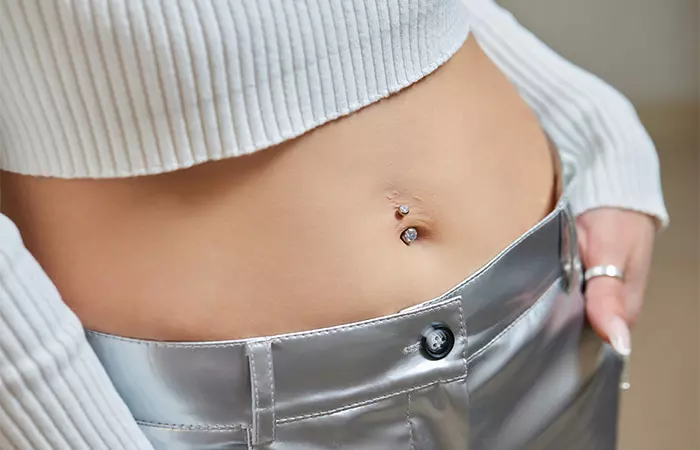
When it comes to surface piercings, the possibilities are nearly as limitless as your imagination. Each one has its own character, and whether it is a subtle statement or a bold move, there is a type that suits every person. Here is a rundown of the various body surface piercing placements you can explore:
- Belly Button (Navel): A classic choice in the piercing world, the belly button piercing loops around the rim of the navel, offering a playground of jewelry options.
- Chest (Sternum): Situated gracefully between the pectoral muscles–the center of the chest–a chest piercing can accentuate the sternum area, creating an alluring focal point.
- Collarbone: These piercings flatter the collarbone’s natural contour, adding a touch of elegance to this often-overlooked area.
- Corset: The corset piercing consists of multiple surface piercings aligned on the back, which can be laced with ribbon for a striking visual effect, mimicking the laced-up look of its namesake.
- Finger: A more uncommon choice, finger surface piercings can act as an alternative to or complement traditional rings.
- Hip: Placed along the pelvic area, hip piercings add a bit of edge and are often done in pairs to symmetrize the look.
- Nape: At the back of the neck, nape piercings offer a subtle surprise element, often revealed by updos or short haircuts.
- Wrist: Surface piercings on the wrist are both delicate and daring, a true conversation starter.
Each surface piercing brings its own unique vibe and set of care instructions. When selecting your piercing, considering your lifestyle and commitment to aftercare can ensure your new adornment heals well and continues to be an expression of your personal flair.
Now that you have learned about the different body surface piercings, check out the different types of surface piercings you can get on your face.
Types Of Face Surface Piercing
Face surface piercings are the ultimate way to express yourself, adding an undeniable edge to your features. Dive into some of the types you can consider:
- Anti-Eyebrow (Top Of Cheek): This piercing, also known as a teardrop, is placed just below the eye, hugging the curve of the cheekbone. It is a subtle yet impactful way to enhance your facial structure.
- Eyebrow: The classic eyebrow piercing can vary in placement along the brow, but always adds a bit of boldness to your look. Whether you go for a vertical or horizontal orientation, it is a time-tested favorite.
- Surface Tragus: The tragus surface piercing is an alternative to the traditional tragus piercing, located in front of the ear canal. It rests flat against the cartilage without puncturing it, and provides a double-pierced look.
- Third-Eye: This piercing is positioned between the eyebrows, at the center forehead, and exudes a mystical or edgy vibe, resembling a third eye, hence the name.
- Tongue (Snake Eyes): This horizontal piercing resembles the eyes of a snake, sits at the tip of the tongue, and is definitely a conversation starter (pun intended).
- Transverse Lobe: A twist on the conventional earlobe piercing, the transverse lobe runs horizontally through the earlobe, offering a fresh take on a classic location.
 Did You Know?
Did You Know?When selecting a surface piercing, consider how it will fit into your daily routine and reflect your personal style. This will also help you make the correct jewelry choices for your new piercing. Take a look at the range of jewelry styles for surface piercings in the next section.
Surface Piercing Jewelry Styles

Dressing up a surface piercing requires a special touch, and thankfully there is jewelry to suit every placement and preference. While aesthetics are important, the type of jewelry used for a surface piercing also plays a crucial role in the healing and maintenance of your body art. Check out your options listed below:
- Straight Barbells: These are as straightforward as they come, featuring a straight metal bar with two ends that can be customized with disks or decorative beads. They are versatile, used commonly for bridge and some genital piercings, but can also be adapted for unique ear projects.
- Surface Barbells: These are the quintessential choice for surface piercings, thanks to their specialized design. With a straight rod and two 90-degree bends, these barbells hug the contours of your body, making them perfect for areas with flatter planes like the chest or the nape.
- Curved Barbells: The gentle curve of these barbells make them a flexible option for various piercing locations. From eyebrows to navels, the curved barbell is a mainstay in the piercing world. They can be adorned with simple beads or more elaborate ends to match your style.
- J-Curves: Unique in their shape, J-curves are an excellent match for rook piercings, often chosen for their fit and flare construction. The curve allows for a snug fit that complements the natural curvature of your ear.
- Navel Curves: Originally designed as belly button bling, navel curves bring a touch of glamor to the piercing scene. They are distinctive, with one end typically showcasing a decorative element, while the other end is left open for various interchangeable options.
When selecting jewelry for your surface piercing, opting for high-quality, body-safe materials is essential to encourage proper healing and reduce the risk of rejection. Furthermore, proper placement and the right surface jewelry, like the staple barbell, are essential to minimize the chances of migration and irritated tissue. Quality jewelry material, such as titanium or 14-karat gold, allow for a smoother experience due to their hypoallergenic properties. Avoid using nickel or other reactive metals, as they can cause irritation and delay the healing process. A few things to keep in mind for a freshly healing piercing is listed in the section below.
Surface Piercing Healing Process

The healing process for a surface piercing is indeed a meticulous one, requiring both time and proper care to ensure successful healing without complications. Below is a detailed look at what you can expect and what you should do during the healing period:
- From the moment the jewelry piercing is done, your body recognizes the jewelry as a foreign object and immediately begins the healing process. The piercing hole and the area around it may initially swell and appear red, which is a normal part of your body’s response to the piercing.
- Cleanliness is paramount to aid the healing, especially for anti-eyebrow piercings that are prone to harboring makeup or other contaminants in the piercing site. You should gently clean the area with a saline solution twice a day to remove any bacteria and prevent infection. This can be done by soaking a clean piece of gauze in the saline solution and holding it against the piercing, or by using a saline spray directly on the area.
- It is crucial to avoid touching the piercing with dirty hands and to resist the urge to move or rotate the surface piercing jewelry, as this can introduce bacteria to the wound or cause irritated tissue, slowing down the healing process. Surface piercings are particularly prone to movement due to their placement on the body, so it is vital to be conscious of this during daily activities.
- During the initial healing phase, which can last several weeks to a few months, it is normal to see some discharge from the piercing as your body heals. Keeping the piercing dry after cleaning and ensuring it is not covered with tight clothing that can irritate it will help to minimize this and reduce the chances of migration.
- As the months pass, the piercing will start to settle, but it is important to maintain a proper surface piercing aftercare regimen until it is fully healed, which can take up to a year for some. The average healing time varies depending on the individual and the location of the piercing. If at any point you notice excessive swelling or redness, pain, or a change in discharge that could indicate an infection, it is important to immediately seek advice from your piercer or a healthcare professional.
- You need to listen to your body throughout the healing process. Adequate sleep, a nutritious diet, and staying hydrated can all support the body’s natural healing abilities.
By following these guidelines and taking good care of your surface piercing, you will increase the chances of a smooth healing process, leading to a beautifully healed piece of body art that you can enjoy for years to come.
 Trivia
TriviaThe healing process requires a clear and simple aftercare regimen. Avoiding any kind of activity that might put undue pressure on your piercing is also crucial, as excessive pressure can increase the risk of migration and potentially lead to an unsightly and retired body piercing. Dry skin around the piercing can also be an issue, so keeping the area moisturized with a fragrance-free lotion recommended by your piercer can be beneficial. Learn more about the needed aftercare practices in the next section.
Surface Piercing Aftercare
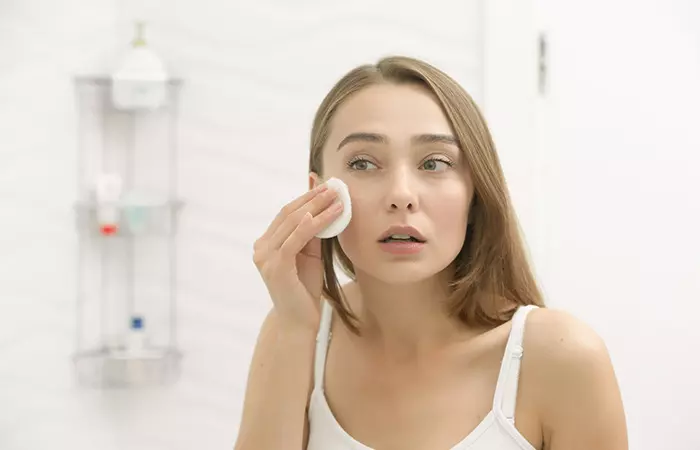
Caring for a surface piercing is not an overly complicated affair, but it does require consistency and attention to detail. Check below for a breakdown of the vital aftercare steps:
- Soak In Saline: A saline soak is the cornerstone of proper surface piercing aftercare (1). Mix non-iodized sea salt with warm distilled water in a 1:2 ratio and immerse your piercing, or apply it with a clean gauze pad. This will help remove debris and bacteria, fostering an optimal healing environment and reducing the chance of rejection.
- Keep Still: Limit the movement of your jewelry piercing as much as possible. Constant motion can agitate the area, delay healing, and increase the risk of scarring. Be mindful of your piercing during activities and while sleeping.
- Avoid Water Contamination: Steer clear of swimming pools, hot tubs, and natural water bodies until your piercing is fully healed. These environments can introduce unwanted pathogens that may lead to infection.
- Maintain Healthy Habits: Proper nutrient intake helps with wound healing (2). Apart from that, adequate hydration and proper sleep can bolster your immune system, directly impacting your piercing’s healing process. Also, avoid smoking and excessive alcohol intake, as they can impede healing (3).
- Dress Carefully: Wear loose, breathable clothing around your piercing site to prevent irritation and ensure air circulation for the wound healing.
- Hands Off: Touching your piercing with dirty hands can introduce bacteria, so keep your hands clean and avoid fiddling with your piece of jewelry.
- Monitor Healing: Keep an eye on your piercing for signs of infection or allergic reactions. Redness, excessive swelling, or unusual discharge are cues to seek advice from your piercer or a healthcare professional. If you see signs of what might become nasty piercing scars, consult a dermatologist for treatment methods.
- Gentle Cleaning: When showering, allow warm water to run over the piercing, and only use a fragrance-free, mild, antibacterial soap, rinsing thoroughly afterward. This is especially important for any standard piercing.
- Choose Quality Jewelry: Opting for titanium surface bars, or even surgical stainless steel ones can be a wise choice as they are less likely to cause an allergic reaction and are lightweight, which can help reduce the chance of rejection.
By incorporating proper surface piercing aftercare practices, you give your new addition the best chance to heal beautifully, allowing you to showcase your new adornment with pride. However, regardless of aftercare, there are also some common problems that come with surface piercing, as discussed below.
What Are The Common Problems With Surface Piercing?
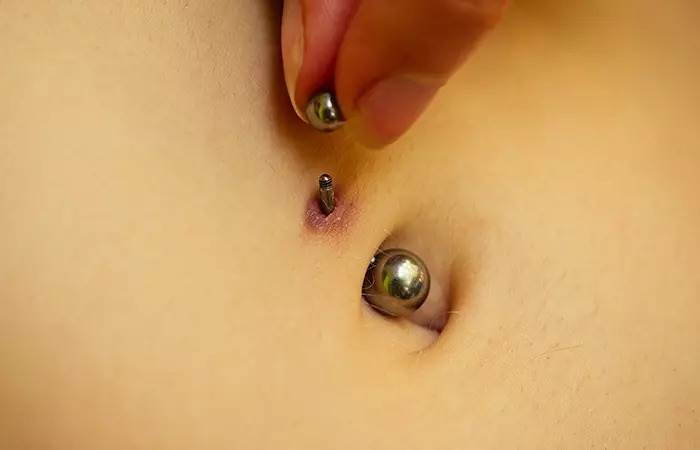
Navigating the world of surface piercings can be exciting, but it is important to be aware of potential complications along the way.
- Rejection: One of the most common issues is the risk of rejection (4). This occurs when your body’s immune system treats the jewelry like a foreign invader and attempts to push it to the surface and out of the skin. Signs of rejection include thinning skin over the jewelry or the piercing gradually moving from its original place.
- Infection: A surface piercing goes through more skin area than a traditional piercing, which means there is a larger wound for bacteria to enter (5). Proper aftercare, such as regular saline washes, is crucial to prevent bacterial contamination and infections.
- Irritation: Sometimes, a surface piercing can become irritated, leading to redness, swelling, and pain. This irritation can stem from friction from clothing, accidental knocks, or even the type of jewelry used.
- Scarring: Scarring is another consideration (6). If a surface piercing heals poorly, or if it is removed after rejection or infection, it can leave a mark. While some are barely noticeable, others can be more prominent, especially if you are prone to keloid scar (raised collection of scarring tissue) formation.
- Migration: This happens when a piercing moves from its original location but does not necessarily get rejected (4). This may cause asymmetry and can be bothersome if the piercing becomes uneven or visible from under the skin.
A blogger recording her experience of getting surface piercings, discussed how she got a much desired surface bar below her anti-brow piercing but had to eventually give up on it because she kept knocking it, which finally led to it being rejected. She writes, “It healed, but I kept knocking it and seemed to go back to square one, I knocked it, got it stuck in my friends hair, pulled it up when I took my jumper off. It was all-too-easy to disrupt this piercing and it was getting very annoying, because it looked great when it wasn’t swollen. I went to a few festivals over the summer and because cleaning facilities were limited it because infected and it started to reject, this happened slowly and eventually after a few weeks of careful nursing of the piercing it became obvious it was beyond repair or hope and sadly I had to take the piercing out (i).”
 Fun Fact
Fun FactBeing aware of these common problems with a surface piercing can help you be vigilant of your piercing and aid in its care. However, if you do face rejection or have to remove your piercing, check below for some pointers to help you.
Can A Surface Piercing Be Repierced If It Is Removed?

Deciding to remove a surface piercing might leave you wondering if you can have a do-over. The short answer is yes, but with some caveats. Re-piercing is all about timing and the condition of your skin. If a surface piercing is removed due to rejection or infection, it is crucial to allow time for complete healing before considering another attempt. This could mean waiting several months or even a year, depending on how quickly your skin recovers.
When it is time to re-pierce, a professional will assess the health and elasticity of your skin. Piercing through scar tissue is possible, but it is typically more challenging and may be more painful. Plus, scar tissue does not always hold jewelry as securely as unscarred skin, which could increase the likelihood of a second rejection.
Your piercer might suggest an alternative location or jewelry type for the new piercing to enhance the chances of success. With the right approach and aftercare, getting another surface piercing can be a gratifying experience, allowing you to enjoy your body art once again.
Surface piercings walk the line between contemporary art and personal expression, offering a distinctive way to express your personal style. Whether it is an understated nape piercing or a bold collarbone adornment, each surface piercing brings its flair to the table. The journey does not end at the piercing studio, though; in fact, it just begins there. These piercings can be a dynamic and satisfying aspect of your self-expression journey with the right care. So take the plunge, care for your piercing with dedication, and wear it with confidence. Remember, while surface piercings can be a captivating addition to your look, being informed about the potential for rejection, infection, and proper healing will help you enjoy your body art for longer.
Frequently Asked Questions
Is a vertical labret a surface piercing?
No, a vertical labret piercing is not a surface piercing. A surface piercing is a type of body modification where the skin is pierced through the outer layer, while a vertical labret piercing is a type of lip piercing that goes through the lip vertically.
How to change a surface tragus piercing?
To change a surface tragus piercing, follow these steps:
• Clean your hands with warm water and antibacterial soap, and the piercing area with a saline solution.
• Gently twist the ends of the barbell to loosen it from the piercing.
• Remove the old jewelry and clean the piercing area again.
• Insert the new jewelry into the piercing, making sure it is properly aligned and secure.
• Clean the piercing area again to ensure it is free from any debris or irritants.
Is a nose piercing a surface piercing?
No, a nose piercing is not a surface piercing. A nose piercing can be done through the nostril, septum, or bridge of the nose, and it involves piercing the cartilage or skin of the nose.
How long does a surface tragus piercing last?
Surface tragus piercings are not as permanent as a standard tragus piercing, and lasts somewhere between 6 to 7 years. However, proper care can help make it last longer.
Surface bar piercing is gaining popularity fast, and it is a fun cool way to show off your quirky style. If you want to know more about the procedure and the fundamentals behind it, check out this informative video below.
Personal Experience: Source
StyleCraze's articles are interwoven with authentic personal narratives that provide depth and resonance to our content. Below are the sources of the personal accounts referenced in this article.
(i) My experience of a surface bar below my eye anti eyebrow piercing
https://surfacebpl.wordpress.com/2010/02/11/my-experience-of-a-surface-bar-below-my-eye-anti-eyebrow-piercing/
References
Articles on StyleCraze are backed by verified information from peer-reviewed and academic research papers, reputed organizations, research institutions, and medical associations to ensure accuracy and relevance. Read our editorial policy to learn more.
- The effectiveness of 7% table salt concentration test to increase collagen in the healing process of wound
https://www.sciencedirect.com/science/article/pii/S0213911121002065 - Impact of nutrition on skin wound healing and aesthetic outcomes: A comprehensive narrative review
https://www.sciencedirect.com/science/article/pii/S235258782400007X?via%3Dihub - Body Piercing
https://youngwomenshealth.org/guides/body-piercing/ - Complications of body piercing
https://www.aafp.org/pubs/afp/issues/2005/1115/p2029.html - Infective complications of tattooing and skin piercing
https://www.sciencedirect.com/science/article/pii/S1876034109000070 - Hypertrophic scarring and keloids: Pathomechanisms and current and emerging treatment strategies
https://www.ncbi.nlm.nih.gov/pmc/articles/PMC3022978/
Read full bio of Rodrigo Casco
Read full bio of Aparna Harry
Read full bio of Madhumati Chowdhury
Read full bio of Vaishali Sinha






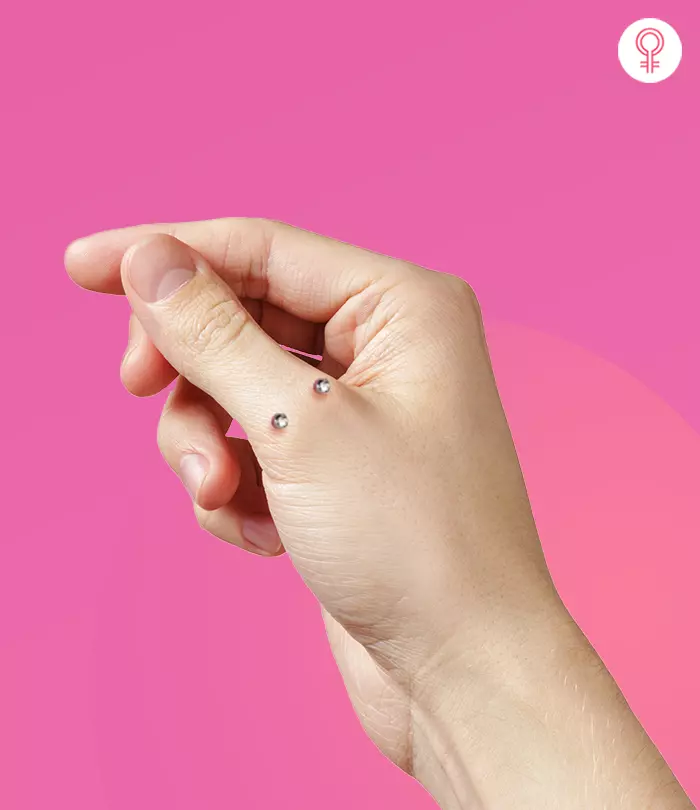
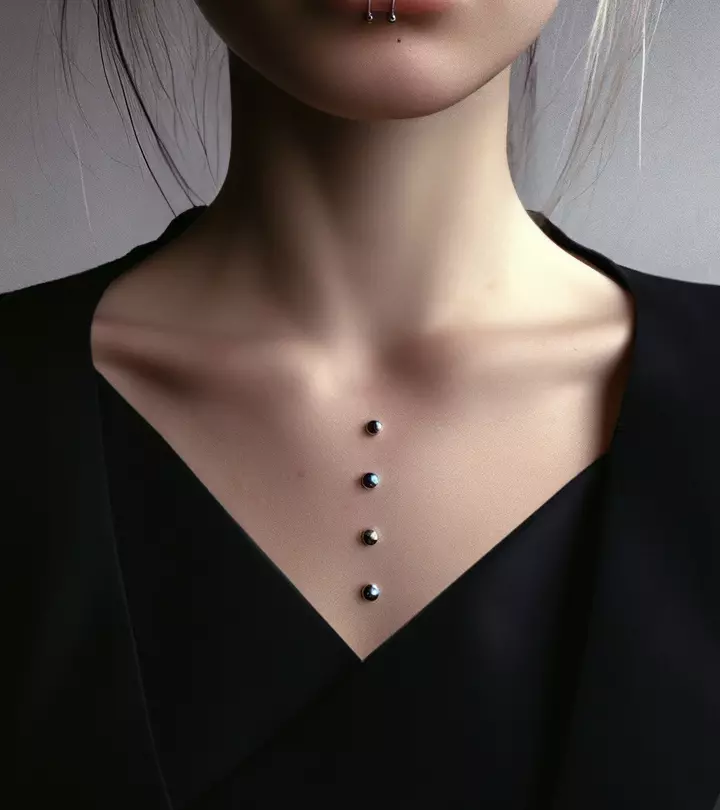




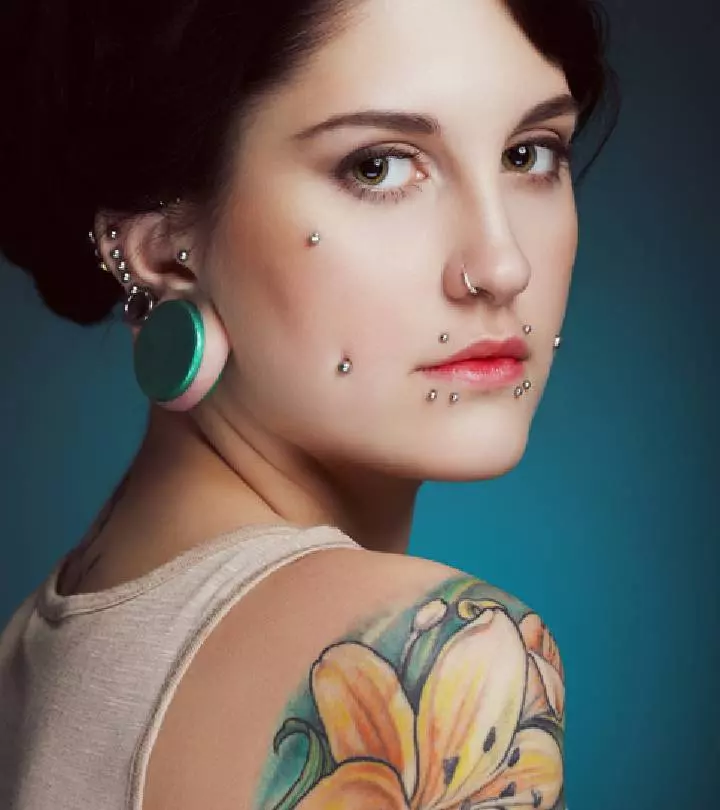

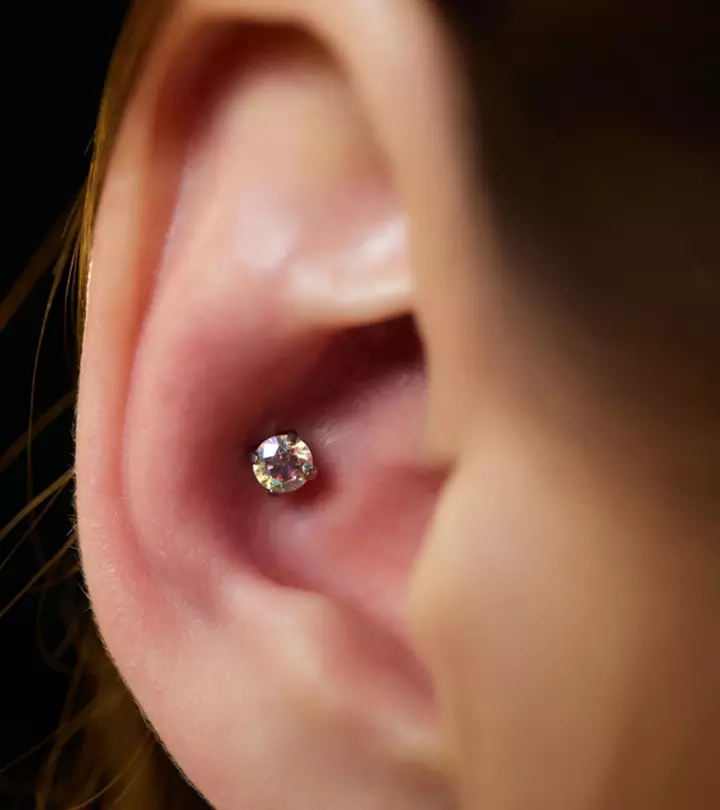
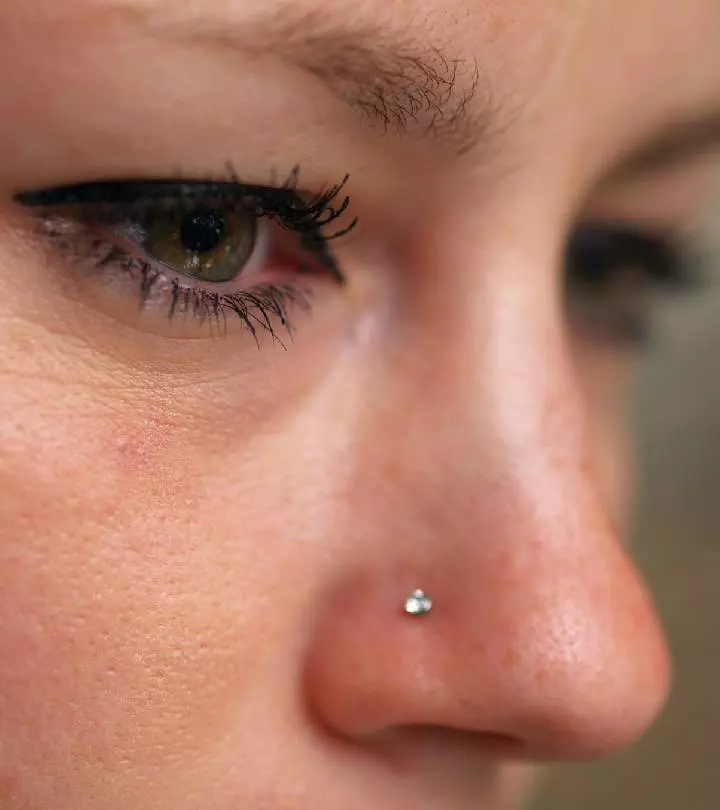



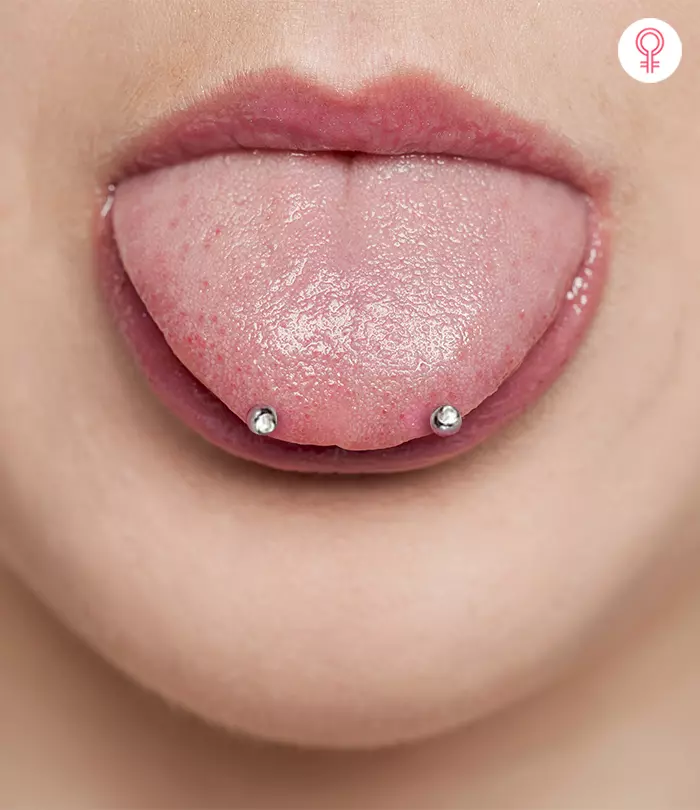
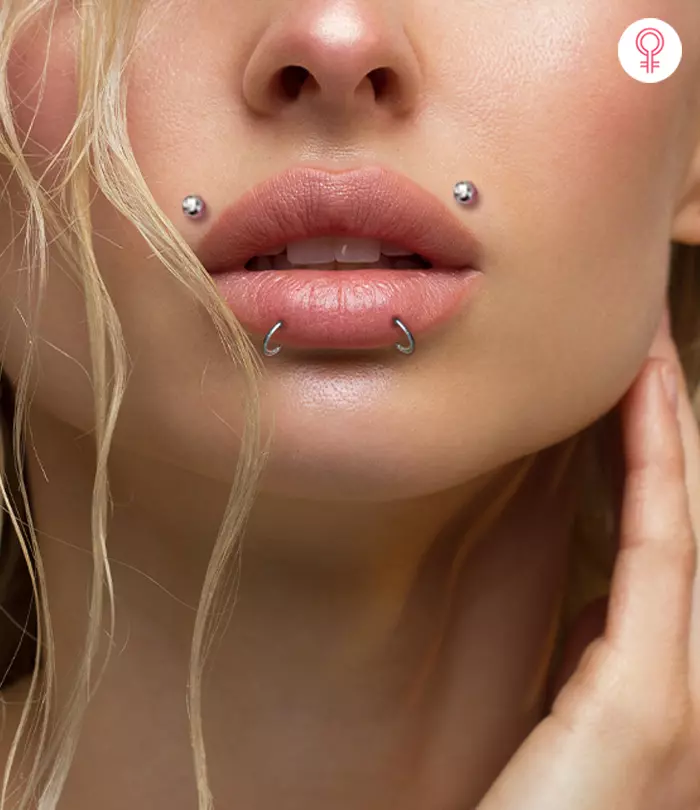
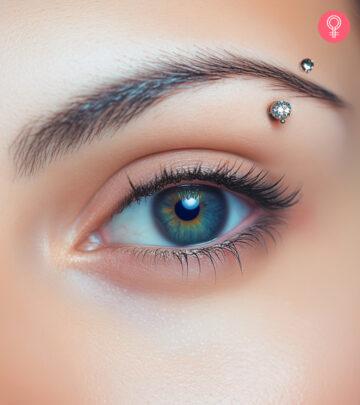




Community Experiences
Join the conversation and become a part of our empowering community! Share your stories, experiences, and insights to connect with other beauty, lifestyle, and health enthusiasts.